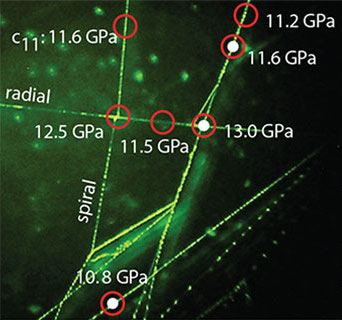Spider Silk Mechanics
February 15, 2013
Mechanical testing of
materials is a routine
laboratory activity. It's become so easy that nearly as much effort is needed to archive and analyze the results as to do the actual
experiments.
ASTM International, formerly known as the American Society for Testing and Materials, has published standard methods for material testing. ASTM was founded more than a century ago to address the pressing need to certify
steel for
railroad rails.

A common sight in materials laboratories is the tensile testing specimen, as shown. Since the cross sectional area of the middle section is smaller than the rest of the piece, all plastic deformation happens in that area. (Image rendered by author using Inkscape and source materials from Wikimedia Commons, here and here.)
Carbon nanotubes and
spider silk are the preeminent
high strength materials of the past few decades. I've written about both of these, most recently about spider silk,
here (Spider Silk, March 12, 2012). The
tensile strength of spider silk (1.3
GPa) is nearly as large as that of high grade
steel. It achieves this with a
density (1.3 g/cc) that's one-fifth as large, and spider silk has a higher mechanical
toughness.
Such high strength derives from spider silk's mixed
molecular structure in which hard,
crystalline regions of
alanine are joined by
amorphous and
elastic glycine linkages. There have been attempts to
synthesize analogous material by
chemical means, but the properties of these materials are not as good. Not surprisingly, there have been experiments in using
genetic engineering to produce spider silk in
bacteria and
silkworms.[1-2]
Accurate measurements are required in any
research and development project because you can't improve what you can't measure. Mechanical measurements other than the simple
stress-
strain curve on spider silk materials are difficult because of the small size of the silk strands.
To improve such measurements, a research team from the
Department of Chemistry and Biochemistry,
Arizona State University (
Tempe, Arizona) has investigated property determination of spider silk by
Brillouin light scattering. The results of their research have been published in a recent issue of
Nature Materials.[3-4]
Léon Brillouin is known to
crystallographers for the
Brillouin zone, and in
quantum mechanics for the
Wentzel–Kramers–Brillouin approximation, best known as just
WKB. Brillouin analyzed the
scattering of light that arises from the density variation in the
refractive index of a material. In the modern form of this experiment, a
laser induces
acoustic waves in the material, and a
spectrometer analyzes the scattered light to determine the material strain.[4]
Lead author of the study,
Kristie J. Koski, who is now a
postdoctoral fellow in the
Department of Materials Science and Engineering,
Stanford University, developed Brillouin light scattering techniques that enabled the non-invasive, non-destructive determination of the mechanical properties of a spider web as created by a spider.[4] The measurements included all five
elastic constants in the
stiffness tensor, and also the refractive indices, and longitudinal and transverse
sound velocities for silk of the spiders,
Argiope aurantia,
Latrodectus hesperus,
Nephila clavipes and
Peucetia viridans.[3]
The Brillouin light scattering measurements reveal the linear elastic response for all possible deformations (e.g.,
compression,
shear), which goes far beyond the result of a stress–strain test. The stiffness tensor also revealed a
negative Poisson's ratio.[3] The technique allowed a spatial mapping of the elastic stiffness, as shown in the figure.

The experimentally measured value of the elastic constant, C11, for various portions of a pristine spider web.
The solid white circles are "glue/goo" spots.
(Stanford University image by Kristie Koski.)
The Brillouin light scattering technique revealed that mechanical stiffness varies along fibers, at intersection points, and at glue spots where the webs are anchored. There may be an
evolutionary advantage in building a web with a certain mechanical plan.[4] Another interesting feature of spider silk is a property called supercontraction in which high
humidity will cause a shrinkage by as much as a factor of two. The present measurements showed that supercontraction is accompanied by additional stiffening, so this feature makes the web
robust against damage when it's wet.[4]
Moisture content's affecting the mechanical properties of spider silk is evidence that spiders may modify the water content of the silk while spinning to adjust the mechanical properties of their web. Says Koski,
"The possibility of adjusting mechanical properties by simply adjusting water content is interesting from a bio-inspired mechanical structure perspective and could lead in interesting research directions as we try to invent new fibers."[4]

Kristie J. Koski.
Note the proper laboratory safety attire, which includes safety glasses, protective gloves, and a lab coat.
(Stanford University photograph by Judy J. Cha.)
![]()
References:
- Xiao-Xia Xia, Zhi-Gang Qian, Chang Seok Ki, Young Hwan Park, David L. Kaplan and Sang Yup Lee, "Native-sized recombinant spider silk protein produced in metabolically engineered Escherichia coli results in a strong fiber," Proc. Natl. Acad. Sci., vol. 107, no. 32 (August 10, 2010), pp. 14059-14063.
- Florence Teulé, Yun-Gen Miao, Bong-Hee Sohn, Young-Soo Kim, J. Joe Hull, Malcolm J. Fraser, Jr., Randolph V. Lewis and Donald L. Jarvis, "Silkworms transformed with chimeric silkworm/spider silk genes spin composite silk fibers with improved mechanical properties," Proc. Natl. Acad. Sci., vol. 109, no. 3 (January 17, 2012), pp. 923-928.
- Kristie J. Koski, Paul Akhenblit, Keri McKiernan and Jeffery L. Yarger, "Non-invasive determination of the complete elastic moduli of spider silks," Nature Materials, Published Online, January 27, 2013, doi:10.1038/nmat3549.
- Andrew Myers, "Stanford Researcher Sheds New Light on the Mysteries of Spider Silk, Stanford University Press Release, February 4, 2013.
Permanent Link to this article
Linked Keywords: Mechanics; mechanical; material; laboratory; experiment; ASTM International; steel; railroad; rail; tensile testing; cross sectional area; plastic deformation; Inkscape; Wikimedia Commons; carbon nanotube; spider silk; high strength material; tensile strength; pascal; GPa; steel; density; toughness; molecule; molecular; crystal; crystalline; alanine; amorphous solid; amorphous; elastic; glycine; chemical synthesis; synthesize; chemical reaction; chemical; genetically modified organism; GMO; genetic engineering; Escherichia coli; bacteria; Bombyx mori; silkworm; research and development; stress; strain; Department of Chemistry and Biochemistry; Arizona State University; Tempe, Arizona; Brillouin light scattering; Nature Materials; Léon Brillouin; X-ray crystallography; crystallographer; Brillouin zone; quantum mechanics; Wentzel–Kramers–Brillouin approximation; scattering of light; refractive index; laser; acoustic wave; spectrometer; Kristie J. Koski; Postdoctoral Fellow; Department of Materials Science and Engineering; Stanford University; elasticity; elastic constant; stiffness tensor; sound velocity; Argiope aurantia; Latrodectus hesperus; Nephila clavipes; Peucetia viridans; compression; shear; negative Poisson's ratio; fitness; evolutionary advantage; humidity; robust; Judy J. Cha.